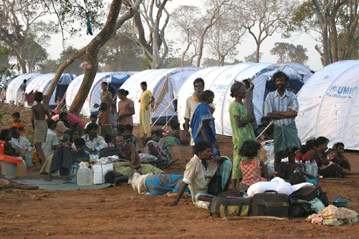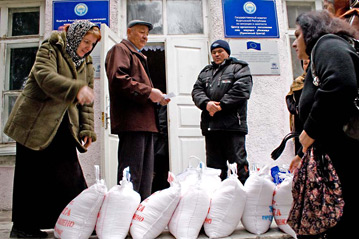Fast track back to Sierra Leone raises hopes of complete repatriation by end 2004
Fast track back to Sierra Leone raises hopes of complete repatriation by end 2004

DANDOU, Guinea, April 7 (UNHCR) - A shortcut goes a long way, as hundreds of Sierra Leonean refugees in Guinea discovered recently when they returned home on a new route that has accelerated returns and raised hopes that repatriation to Sierra Leone could be completed by the end of next year.
On Friday, a first convoy of 300 refugees returned to Sierra Leone on a new direct route through the previously volatile "Parrot's Beak" region. From their camps in central Guinea's Albadaria area, they travelled through southern Guinea's Guéckédou, crossed a new causeway over the river at Dandou and arrived in north-eastern Sierra Leone's Kailahun area in less than a day.
"This marks an important phase of the Sierra Leonean repatriation and the consolidation of the friendly relation between the two countries and the two populations," said UNHCR's Representative in Guinea, David Kapya, at the inauguration ceremony at Dandou. "Different developments in the repatriation operations that started in the year 2000 show how far progress has been made in the restoration of peace and security in Sierra Leone."
Friday's ceremony was attended by representatives from the governments of Guinea, Sierra Leone and Germany - which funded the construction of the causeway - and other donor countries.
Refugee leader Lucy Yollah said, "After 13 years in exile, I can only thank our hosts and UNHCR for their hospitality and assistance." She encouraged her fellow refugees to return to Sierra Leone, stressing that the skills training and assistance given to women and young girls in Guinea would allow them to look ahead with hope for a new life and to contribute to their own country's future.
After crossing the border, the returnees were welcomed by a local leader at the Kailahun way station, who assured them their land had not been possessed illegally in their absence. They spent a night at the way station before moving on to their home villages with returnee packages of food and domestic items.
A second convoy of 500 returnees arrived in Kailahun on Sunday. Initially, the Parrot's Beak route should allow the UN refugee agency to send 500 persons on alternate days from Albadaria's camps to Kailahun. A concrete bridge should be added soon.
The Parrot's Beak region (known locally as "Languette") once hosted hundreds of thousands of Sierra Leonean refugees who had fled the cruel wars in Sierra Leone and Liberia since the early 1990s. In September 2000, the region became the theatre of violent cross-border attacks from Sierra Leone and Liberia, forcing UNHCR to relocate the dozens of refugee camps to a safer place in central Guinea. In the confusion that followed the attacks, tens of thousands of refugees returned on their own to their country, crossing rebel-held territories at their own peril. Many were harassed, abducted or abused.
Shortly after, in December 2000, UNHCR started facilitating the return of Sierra Leonean refugees by boat from Conakry to Freetown, in a bid to discourage refugees from using the then-hazardous Parrot's beak route. In a little over a year, 37,000 refugees were shipped back to Freetown, where they were either transported to their home areas or assisted in transit centres.
Following the end of war and the April 2002 elections in Sierra Leone, convoys were set up through Kambia, north of Conakry, to reach Sierra Leone by land. The movement was shortly interrupted in June and again in November 2002 due to financial constraints. Up until now a total of 23,000 Sierra Leoneans have been brought home through this route.
In addition to the new Guéckédou-Kailahun route, the convoys through Kambia will continue twice weekly to Kono district in eastern Sierra Leone. Although a longer route, it will remain an attractive option for refugees in Guinea's Dabola, who originate mostly from Kono, because of the better quality of the roads inside Sierra Leone.
So far, UNHCR has helped repatriate a total of 60,776 Sierra Leonean refugees from Guinea. This year, the agency hopes to assist up to another 26,000 refugees home before the start of the rainy season in June.
Currently, there are still some 35,000 Sierra Leonean refugees living in camps in Guinea. A recent survey by UNHCR showed that up to 80 percent of them want to return home this year.
The refugee agency's camps in Guinea also host about 62,000 Liberian refugees and 3,600 Ivorian refugees who fled their country recently.
Meanwhile, in war-torn Liberia, the Sierra Leonean refugees' desire to return has been tempered by logistical constraints. In view of the deteriorating security in camps around Monrovia, UNHCR started an airlift in February this year. So far, 357 people have been flown back at an average rate of two flights per week.

Last year, UNHCR helped more than 13,000 Sierra Leonean refugees go home from camps in Liberia.
In all, the agency has assisted over 200,000 Sierra Leoneans in the region to return and settle back home since late 2000. Surrounding countries are still hosting some 100,000 Sierra Leoneans, with 73,000 in Guinea alone (35,000 in camps, the rest spontaneously settled).
UNHCR hopes to complete the repatriation of Sierra Leonean refugees by the end of 2004.









